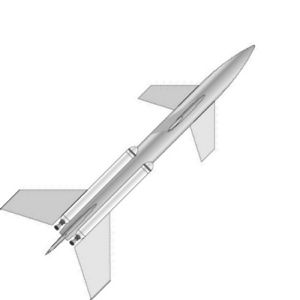
Home - Search - Browse - Alphabetic Index: 0- 1- 2- 3- 4- 5- 6- 7- 8- 9
A- B- C- D- E- F- G- H- I- J- K- L- M- N- O- P- Q- R- S- T- U- V- W- X- Y- Z
R-117
 R-117 Credit: © Mark Wade |
Status: Cancelled 1950. Thrust: 117.00 kN (26,302 lbf). Gross mass: 1,220 kg (2,680 lb). Height: 5.00 m (16.40 ft). Diameter: 0.43 m (1.41 ft). Apogee: 20 km (12 mi).
The R-117 was a medium surface-to-air missile of original Soviet aerodynamic design and developed in competition with the R-112. Even before the end of the war, Babakin was put in charge of a rocket design team of 18 engineers in 1944. This little group began work on surface-to-air missiles in 1945. There was an 18 month interruption after the fall of Berlin to take on German technology. The initial design of the missile was by VNII VSNITO (All Union Automatic Research Institute / All-Union Scientific-Engineering-Technical Organization). The draft project was completed and defended before an expert commission on 1 March 1948. The draft project called for a 750 kg missile, with a 100 kg warhead, 20 km range, and 40 m accuracy at 20 km. Top speed would be 2900 kph, and the missile was to be 4.727 m long x 0.38 m diameter x 0.76 m wingspan x 1.12 m span over the fins. The two metric ton thrust engine was powered by nitric acid and kerosene, had a specific impulse of 162 seconds and a burn time of 25 seconds.
The commission faulted the concept as still needing serious ballistics and aerodynamic work. Solution of the problems of the proximity fuse was considered especially problematic. Therefore a second draft project for the design was reviewed on 28 April 1948. The missile was now 1220 kg total mass with a 200 kg warhead, a maximum range of 25 km, and effective at altitudes from 3 to 20 km. 5 m long x 0.43 m diameter, it was equipped with four solid boosters of 2.5 metric tons thrust each and single 2 metric ton thrust liquid sustainer engine, which ignited together with the boosters at launch. All five engines produced 12 metric tons thrust. The boosters had a total mass of 160 kg and operated for only 2 seconds before dropping away. The missile was already moving at 30 m/s when it left the launch rail. The nose had proximity fuse and air scoop to provide for pressurization of the propellant tank. This was followed by the guidance and electrical sections. There were four movable wings swept back at 45 degrees, and four fins at the base. Two guidance methods were designed for the R-117. V A Ivapeznikov pursued the 'dog' method of guidance - the missile would overtake the target, and then turn to destroy it. Babakin pursued guiding the missile to a specific point in space and time where the ground tracking station predicted the target would be.
Go-ahead for development of this design to the technical project level was granted, with the designation R-117 assigned. To implement this Babakin's team was formally set up as Section 6 of Sector 16 of NII-88 in December 1949. In March 1950 this group was moved to Section 5 of NII-88 under S Ye Rashkov, followed by a move of the entire to the new OKB-2, still within NII-88, in June. Babakin was put in charge of guidance development in section 8. Further development work on the R-117 was halted when the R-112 was chosen over the R-117 in June 1950.Ironically, further work on the R-112 was in turn cancelled on 17 August 1951 (together with all other derivatives of German missile designs).
Maximum range: 25 km (15 mi). Warhead yield: 200 KT. Boost Propulsion: Solid rocket, 4 x 40 kg boosters. Cruise Thrust: 19.600 kN (4,406 lbf). Cruise Thrust: 2,000 kgf. Floor: 3,500 m (11,400 ft).
Family: surface-to-air. Country: Russia. Agency: Lavochkin bureau. Bibliography: 571.
Back to top of page
Home - Search - Browse - Alphabetic Index: 0- 1- 2- 3- 4- 5- 6- 7- 8- 9
A- B- C- D- E- F- G- H- I- J- K- L- M- N- O- P- Q- R- S- T- U- V- W- X- Y- Z
© 1997-2019 Mark Wade - Contact
© / Conditions for Use